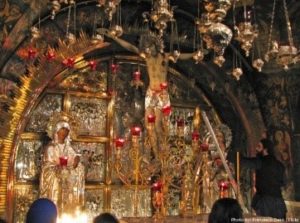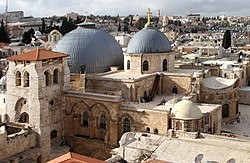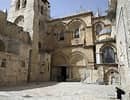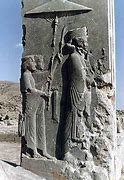PART XI: Some History of Zion, Jerusalem’s Temple Mount, and Jerusalem’s Church of the Holy Sepulchre
The church of today, including its owners


To understand Jerusalem’s chequered history and especially the temple mount and the site of the present Church of the Holy Sepulchre, it is necessary to have a description of the architecture and its convoluted Christian history and current status.
The area of paramount importance both historically and religiously is the Calvary, and it is a good place to start. On the south side of the altar–via the ambulatory [covered passage]–is a stairway climbing to Calvary/Golgotha, traditionally regarded as the site of Jesus’s crucifixion and the most lavishly decorated part of the church. The main altar there belongs to the Greek Orthodox, which contains the Rock of Calvary. The rock can be seen under glass on both sides of the altar, and beneath the altar there is a hole said to be the place where the cross was raised. Due to the significance of this, it is the most visited site in the Church of the Holy Sepulchre. The Roman Catholics [Franciscans] have an altar to the side, the Chapel of the Nailing of the Cross. On the left of the altar, towards the Eastern Orthodox chapel, there is a statue of Mary, believed by some to be miraculous.
At present the building itself is controlled by six Christian churches [Denominations: Catholic, Armenian Apostolic, Greek Orthodox, Ethiopian Orthodox, Syriac Orthodox, and Coptic Orthodox ]; the division of the site can be traced from the 11th century and was solidified into law by the Ottomans in 1767. Beneath the Calvary and the two chapels there–on the main floor–there is the Chapel of Adam. According to tradition, Jesus was crucified over the place where Adam’s skull was buried. Some serious believers state that–at the crucifixion–the copious blood of Christ ran down the cross and through the rocks to fill the skull of Adam. The Rock of Calvary appears cracked through a window on the altar wall, with the crack traditionally claimed to be caused by the earthquake that occurred when Jesus died on the cross; some scholars more prosaically claim it to be the result of quarrying against a natural flaw in the rock.
Just inside the entrance to the church is the Stone of Anointing, by tradition believed to be the spot where Jesus’ body was prepared for burial by Joseph of Arimathea. However, this tradition is only attested since the crusader era, and the present stone was only added in the 1810 reconstruction.




The Church of the Holy Sepulchre site has been recognized since early in the 4th century as the place where Jesus was crucified, buried, and rose from the dead. The church was consecrated on September 13, 335. In 327, Constantine and Helena separately commissioned the Church of the Nativity in Bethlehem to commemorate the birth of Jesus.

The New Testament describes Jesus’s tomb as being outside the city wall, as was normal for burials across the ancient world, which were regarded as unclean. Today, the site of the Church is within the current walls of the old city of Jerusalem. It has been well documented by archaeologists that in the time of Jesus, the walled city was smaller; and the wall then was to the east of the current site of the Church. The city was much narrower in Jesus’s time, with the site then having been outside the walls; since Herod Agrippa [41-44 CE] is recorded by history as extending the city to the north beyond the present northern walls. the required repositioning of the western wall is traditionally attributed to him as well. The area immediately to the south and east of the sepulchre was a quarry also outside the city during the early first century CE.


